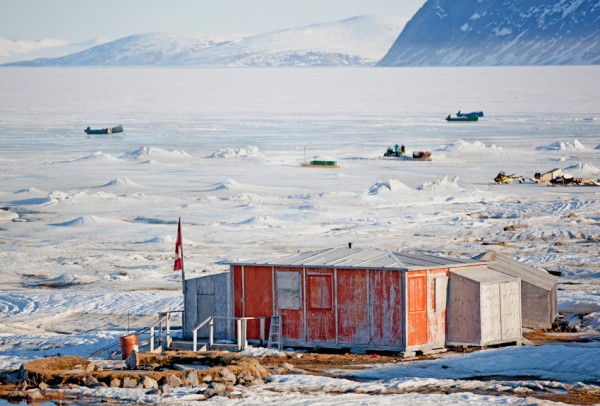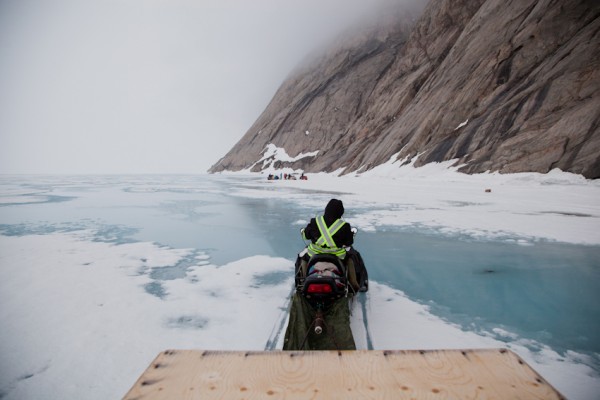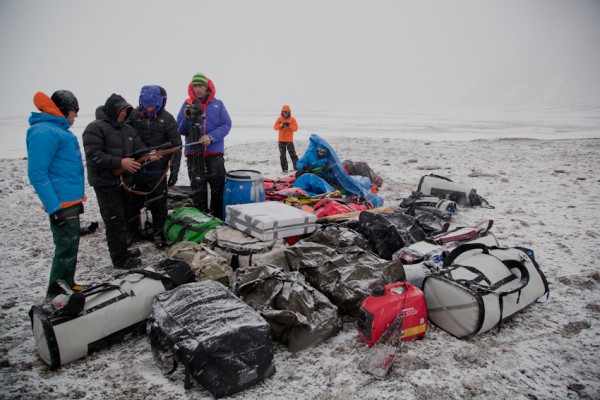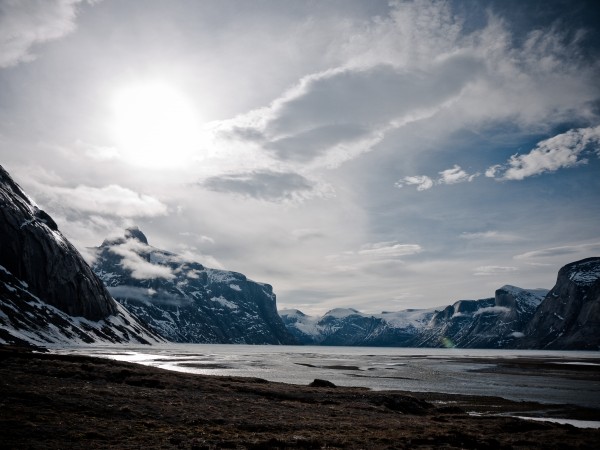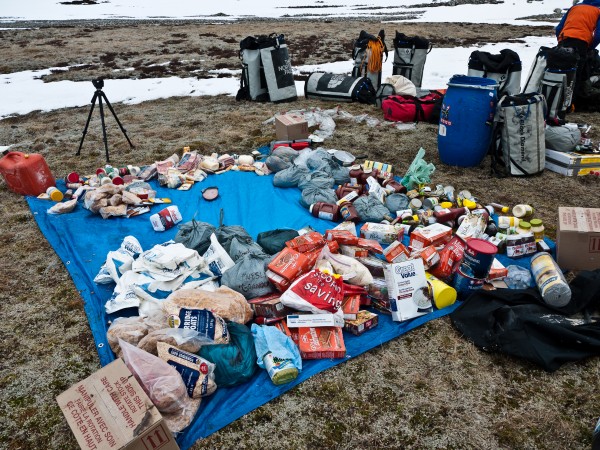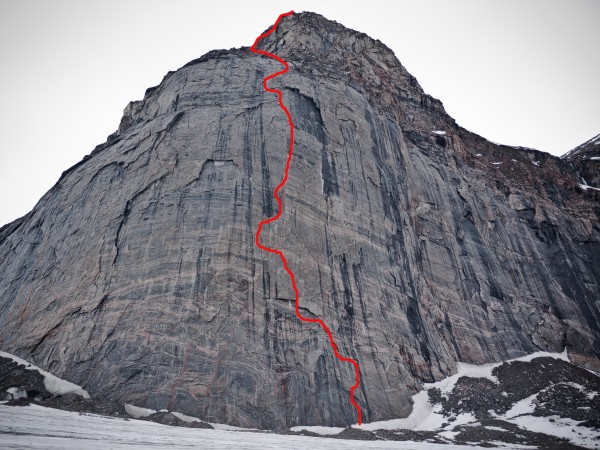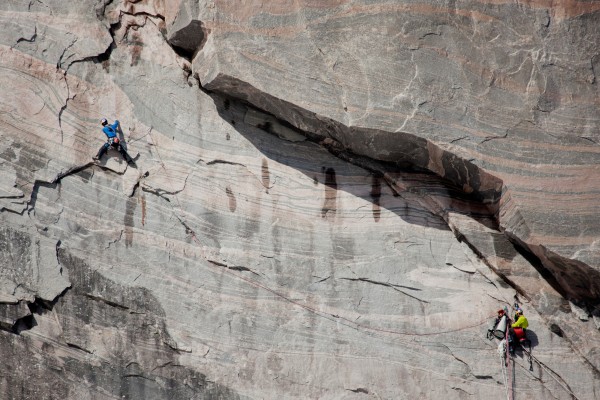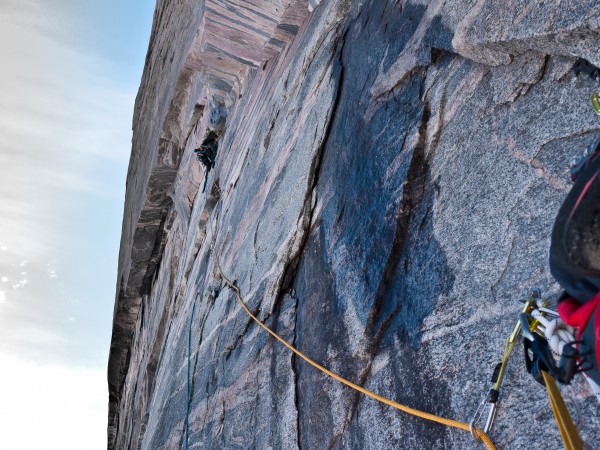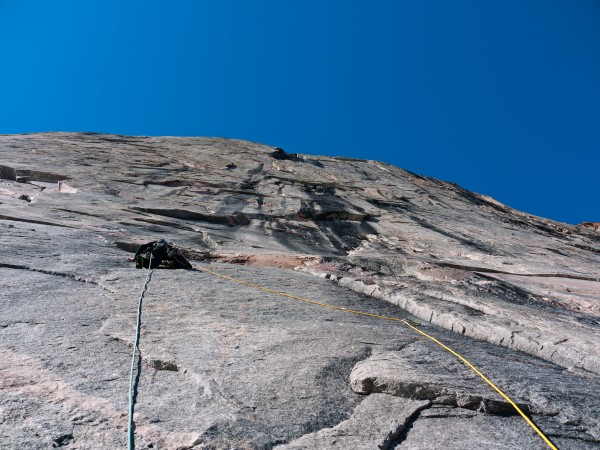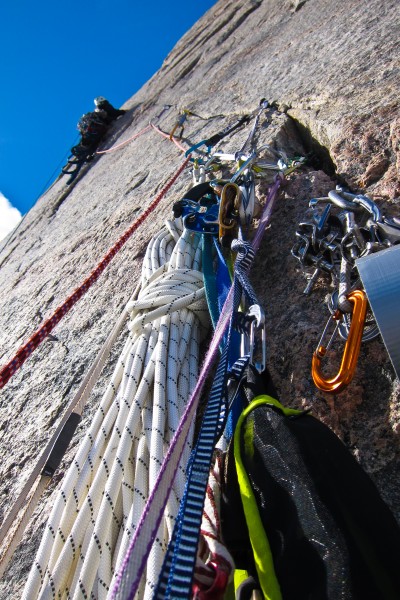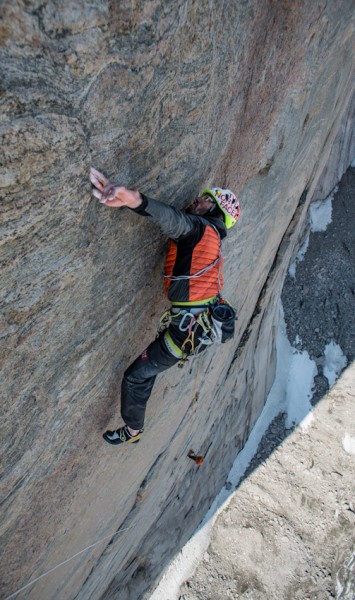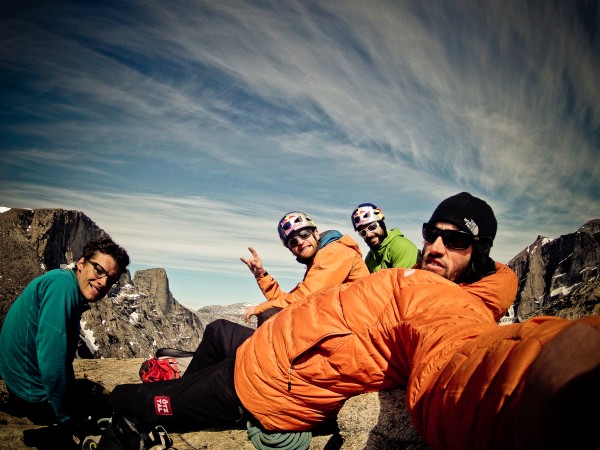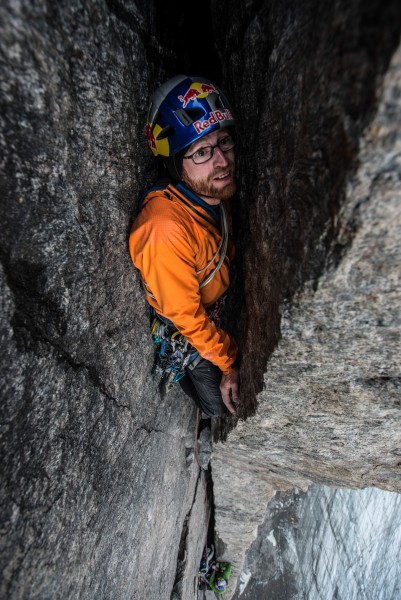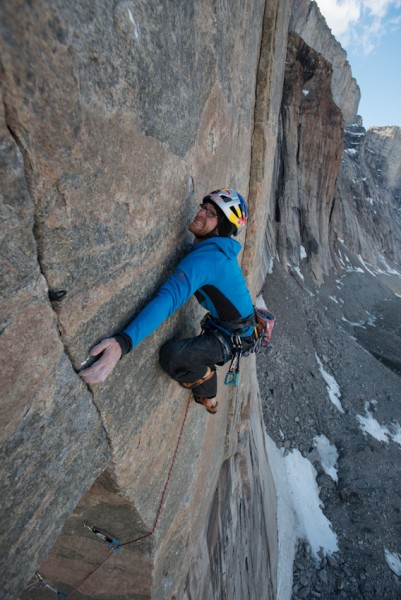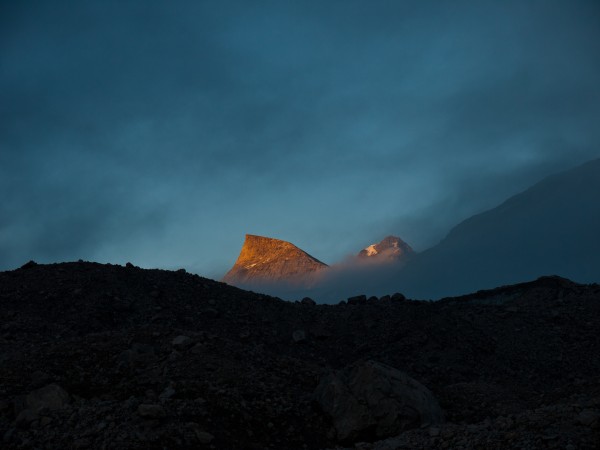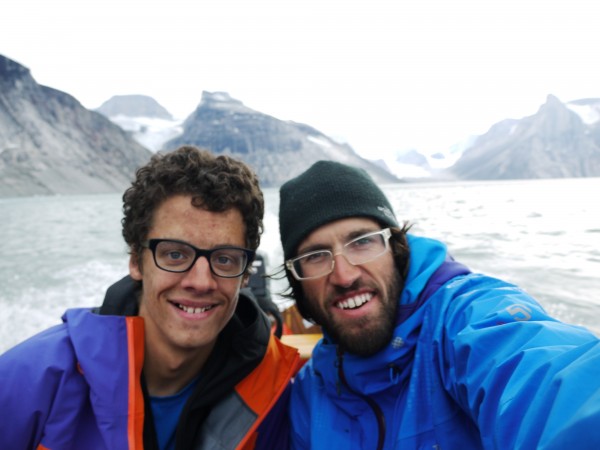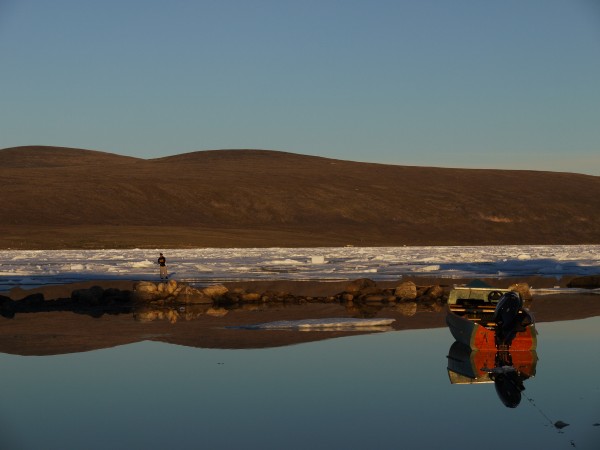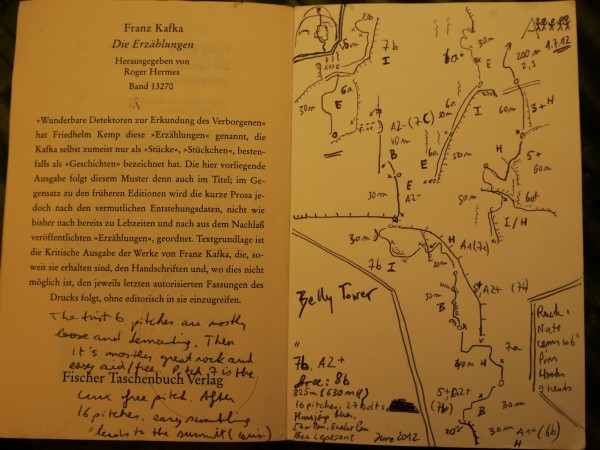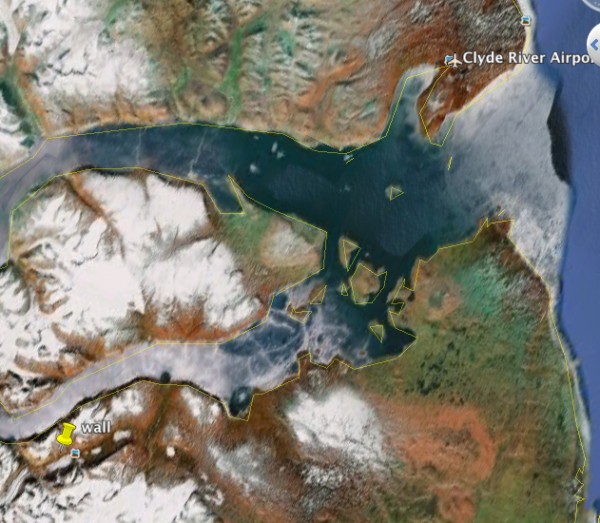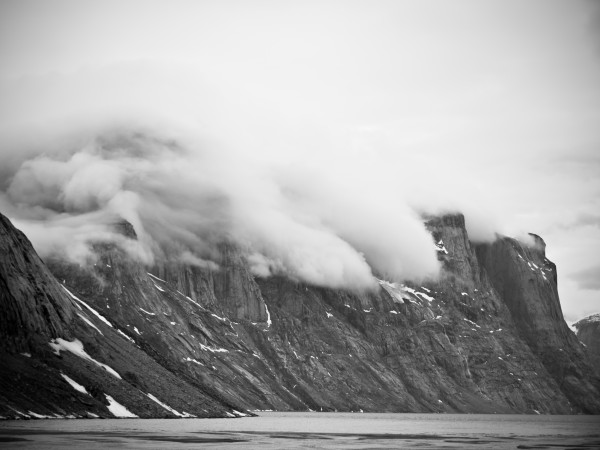I guess we should call Levi. The weather may be good, but I am ready to get out of here. We all are, I think. The question is, can we? It’s a stunning day, except for the mosquitos, in Inugsuin Fiord on the East Coast of Baffin Island.
July 17
William reaches Levi at work, and asks if he can pick us up sooner than the 26th, the original pick-up date. He says he “will try on Saturday”, the 21st. We should call him in case he doesn’t show up.
July 19
After 10 days of splitter weather and worsening mosquitos the clouds start building and the wind picks up. We get a new forecast from Javi predicting precipitation and increasing wind. It looks like the boats might have trouble coming. I wonder if all the ice has melted for the boats. We call Levi again.
More than a year before…:
June 7, 2011
Hansjörg and I exchange emails about a place in Baffin Island named “Perfection Valley” on the map. A picture by Jason Briner got us excited. This looks like a place worth checking out. After a bit of research, it is clear that we will have to stay in Basecamp for 40-50 days, and that getting out earlier than that is not possible. This obviously lowers the number of people who are willing and able to go.
July 2011 – May 2012
Hansjörg suggests that we ask his Basque friends and colleagues Iker and Eneko Pou. They expressed interest in joining him on an expedition in 2012, and he had only good things to say about them. Luckily, they agreed to come. I will spare you the details of planning this trip (it was a very new, exciting thing to do, but kind of type 3 fun). With the amazing support of The North Face and Red Bull, we booked our flights from Ottawa to Clyde River on May 25. We arrived in Clyde River on June 3. Two photographers, Richard Felderer and Matteo Mocellin, from Italy. My friend William Peterson from Washington, who took care of all kinds of basecamp logistics, including food and the polar bear threat. Then finally the four climbers. Seven people, with little to no contact among many of the individuals before the trip. Five languages, with only marginal English shared by all. This was going to be interesting on many levels.
June 7-June 19, 2012
Traveling in wind, rain and snow that will keep us company for the next two weeks, we arrive near the southern end of Perfection Valley led by our outfitter, Levi Palituq.
He drops us off with our 1100 kg of gear and food where we eventually site our base camp. The clouds hang deep. If Hansjörg and Eneko hadn’t checked the place out a few days before, we would have no idea where we were even in relation to the stunning walls. We spend one of these early days in the rain and snow hiking to the base of the wall that from Hansjörg’s pictures looks like the most accessible and hopefullydry wall around. Needless to say we were drenched. The Sat Phones come out… They are the only means of contacting someone who is not on this expedition. They represent a window into something we would not have for another 40 days, and as boredome takes over, this gets more important. As I hear the others’ stories of previous expeditions, it becomes clear that not being able to see another person at all is quite unusual on most climbing expeditions. Usually there are other expeditions nearby, or at least there is a village a few days of walking away. The sea ice during break up is a barrier that neither us, nor the inuit can cross. Going back over land would be a suicide mission. The whole picture only sets in gradually. During these days the notable distraction for big-tent living comes as Eneko and my tents get blown away. Eneko’s lands in the stream with a broken pole. Mine makes it across andsurvives, mostly. Good that Eneko can keep his cool as things seemingly fall apart. It annoys me that I have not seen the entire wall – or any reachable wall for that matter.
June 19 – June 25
Hansjörg and I decide to go to the wall. The main river, which we fortunately don’t have to cross has become much bigger. It is unbelievable how much the way to the wall has changed within a few days. The second half of the hike traces over a flat glacier, with the snow still deep and still wet. It takes us 5 hours to reach the wall, but at least we get to see it. We hang a portaledge on a block and sleep. The next morning, the weather is far from good. It seems like the most demanding section will be the first 120m. The rock looks loose, and every climbable feature seems to be a fully or mostly detached flake. After that, a beautiful, splitter leads to a large ledge and lower angle, though still technical terrain. Hansjörg climbs the first pitch, an arching dihedral, french free in climbing shoes. With the wind blowing hard, the cold temperatures, and intermittent snow, we are both thoroughly frozen after he reaches a belay 100 ft. up. While belaying I think about pneumonia and otitis media. [Although compared to what the Polish climbers faced on Polar Sun Spire earlier this year, this was beautiful warm weather. Look here if you want to see some impressive pictures. But we are soft western European boys after all, and got well cold.] Hansjörg raps and we crawl into the portaledge to warm up. It takes a few hours and we are back to the climb. The weather has marginally improved, but the wind is relentless. I start up the next pitch in full aid regalia, with boots and gore-tex, expecting thin stuff and hooking to reach a decent ledge below a more obvious looking feature. After a few thin moves , I stand on a scratchy, marginal hook, with a flat, 10cm wide, slopey ledge right in front of my nose as I top step. It’s a mantle that would possibly be easy with climbing shoes and normal weather. Here and now I am tempted to just drill a bolt. I convince myself that there is nothing to hit if I fall and grovel onto the ledge. I move across two or three meters and start drilling. It’s a miserable 25 minutes but there it is, a bolt. I free climb over a little more until the ledge disappears and I need another hook from which I can reach some crimps. 2 free moves and I am below a loose, thin flake. I can’t free my second hand, stupidly drop the glove in my mouth when I open it too much and the 000 C3 is clearly too big. I look at it a little more, and not being able to reverse the moves I let go. I take a little fall, but I think I know what to do. With a beak and a LA between my teeth I get back to the flake. I place the beak with one hand then hold on to it to place the LA right next to it, which makes the beak fall out, but I catch the LA. Whoo. I drill the anchor bolts and we retreat to the portaledge. The next day the weather improves to the point where we can wear appoach shoes and free climbing seems conceivable despite very cold fingers. Hansjörg gets pitch 3. The arch we intended to climb is closed and takes no gear. Fortunately we got our ropegun, and this pitch becomes a runout 7a with only 2 bolts drilled from stances. We are at the base of the arch leading to the splitter crack! We stay a few meters left of the arch, and I climb a loose detached flake to some wet and dirty stuff that is technically straightforward on the smallest C3′s but falling into the gap between the wall and the flake is uninviting. The highlight of the pitch is a little hook throw, my first. The weather has kept getting better during the day and as Hansjörg climbs the next pitch, a short A1, Iker and Eneko show up at the base. It’s the first time Hansjörg starts off the anchor in boots and intending to aidclimb from the start. A few flakes that need care and love make this seem like a reasonable approach. It looks like there is 1 or maybe 2 difficult pitches to the splitter, and we rap down because we think it’s late and we have no watch. It’s not even 5! The light that isn’t changing makes it impossible to tell the time.. Iker and Eneko are super eager to climb and the next day they climb the remaining pitch below the arch and get to the big roof where the splitter starts. This turns out to be much easier than expected. It takes a bolt to get out of the arch and into the splitter, and it is not clear whether or not this goes free, according to Iker. Eneko spends the rest of the day climbing the splitter, his first time aid climbing in many years. He has not forgotten how to place pins though. What a pitch! The weather is great, warm and no wind. I belay Hansjörg as he frees the first 5 pitches, all on his first try. He briefly checked the second pitch on toprope. His “flash” ascent of the 4th pitch (7b), called “too many dicks on the dancefloor”, is scary to just watch while belaying. So far the difficulties aren’t too high with pitch 5 being the hardest at 7c.
The next day it rains all day, and we just sit in the portaledge, sleeping and talking. The weather is good again the next morning. While Hansjörg and Iker try to free Eneko’s Splitter, I climb the second part of the splitter, which is one of greatest aid pitches I have ever seen. It’s even better than the Rurp Pitch on Tribal Rite and takes offset cams, micronuts and many beaks.
Eneko is now our lucky boy, and he gets to climb an absolutely splitter 5.9 hand crack. It’s unbelievable. Hansjörg and Iker both stop trying Enekos Splitter, and move on to the pitch I just opened. Iker barely misses a flash send. A reachy move halfway up keeps him from sending, and he stops trying when, after two tries, Hansjörg has the pitch(7c) in the bag, placing all the gear himself. If one of the team frees a pitch, there is no point for the others to waste energy at this point. Things are going well, although the roof is making trouble and a big question mark remains. We reach a ledge, on which we unfortunately drill 3 bolts, the only ones of the day, to make a portaledge camp we never end up using. I go down to belay Hansjörg on the roof boulder problem, and Iker fixes another pitch above the ledge. Hansjörg does all the moves separately, but it sure doesn’t look like a quick send and the thing seems to be wet more often than dry. In the morning, there was quite a large rockfall straight over our haulline. It missed us by a couple hours, and Riky only by 40 minutes. A huge slab/flake dropped 30cm or so, leaving an arsenal of big and small rocks ready to peel off. We hope the entire flake system isn’t going to collapse. We move the fixed line to the left to a safer area with different rock. The rising temperatures cause constant rockfall and slides all around us.
Hansjörg and I descend as the weather worsens that evening and we have bad weather in the forecast for the next day. Iker and Eneko want to go down the next morning, but it turns out that day is the best so far and we enjoy it hanging out in basecamp and drying our stuff, while Iker and Eneko fix the rest of our static line by climbing 4.5 new pitches up an obvious chimney-dihedral feature and some slabby faceclimbing up to 6b. It looks like we are very close to the ledge below the summit now. All there is left to do is wait for good weather.
July 1
Summit Day. We walk to the wall through the fog which soon dissipates in the morning sun. After jugging to the highpoint, Hansjörg and I quickly climb easier terrain up to the big scree ledge, and wait for Riky, Iker and Eneko to jug up after they finish some filming. We walk to the summit from there and happiness sets in. Compared to many other Baffin walls, we haven’t done an exceptionally big or hard to open route, but it is of amazing quality, and with a bit of luck it may be possible to free it. We lie in the sun, enjoying the view and build a little cairn. Man this feels good. We rappel, and I belay Hansjörg some more on the crux pitch, while Iker, Eneko and Riky do some more filming. The main thing that there is to do now, is to free the crux pitch. The next day Riky films all of us a little bit. I get to reclimb the first few meters of the second splitter. I am happy that he understands and agrees that if we reenact the FA of the pitch, the filming has to be done from below. The perspective is important to us for a documentary film, even if that means less spectacular footage. I think that climbing should be shown from an angle that is realistic. And showing “the FA” being filmed from above would be taking the public for a fool. Hansjörg and Iker figure out a way to climb the crux pitch, which they estimate to be about 8b. A bolt is added for freeing the pitch. It is all about avoiding a barn door, and thus the pitch, and later the route, get the name “The Door.” It is a big advantage that we have two strong freeclimbers in our team of 4, and they could figure out the beta and try that pitch together.
July 7
Iker and Hansjörg had been up there and tried the pitch for two days now. Only Iker had gotten past the roof boulder problem, and he had fallen off at the very end of the pitch. I leave Basecamp with William to watch the final show. At least we hope this is the last chapter of a mental battle for our two machines working the crux. As we get there, Iker is already past the boulder problem. We cheer him on. He climbs with confidence. This time he makes no mistake on the technical second part of the pitch which follows a tiny crack which only serves as a sidepull occasionally until it widens enough to allow a few jams to get to the anchor. The route is free! Still, euphoria only lasts so long. It’s Hansjörg’s turn. He gives it a try, but he swings out. Another try… another fall.. I wonder how much pressure he feels. He rests at the belay. Still, he falls again. The mental battle is in full effect now. Come on, man.A little later, he gets past the boulder problem for the first time. Another short stretch of sketch, and he is at the first rest position. My arms hurt from holding the binoculars, but I know that this is in the bag. He is in his terrain now.. He’s nervous, but doesn’t mess up, fortunately. We have come here to do a new route from the bottom, with no powerdrill and free it as far as possible. From the start, we had done everything to increase our odds, but until now we could not be completely satisfied. Now it finally turns out that we chose the right line in the right place at the right time and got rewarded with a result to be proud of. While it was most important to me to get to Baffin because it meant a new experience of improbable grandeur, I also wanted to use the opportunity to do something that I could consider relevant on a more objective level. I am still baffled about how lucky I was to get to go with this team of six extraordinary characters that made this happen.
In the beginning, Hansjörg and I, but especially me, wanted to climb whenever the condition seemed to allow upward progress. With many expeditions below their belt, Iker and Eneko, had much less trouble relaxing in basecamp to wait for actually good conditions. But young and in my case inexperienced wants to act, whether it’s the smarter thing to do or not, sometimes. We got us started in mediocre conditions, so that we were ready to free the first pitches when the weather finally got good and they were dry for the last time. Later, when it came down to going to the summit and freeing the route, I tried to adopt some of their coolness, but this time they pushed a bit more, and we got it just right following their initiative. We are lucky that we turned out to be a team that really works together, not only as expected in pairs, but also as a group of four.
July 8 – July 16
With mostly good weather, but also more mosquitos, basecamp life becomes more pleasant. On the 13th, we climb 2 routes above basecamp on a small pillar to the right of quite an impressive wall, named in honor of the big tent, which was alternatively called Hotel Gina (6b+) and Hotel Monica(6b+). We climb in teams of 3, joined by the photographers. It’s a good day of quite adventurous climbing. I take a fall on the first pitch and hurt my ankle a bit, and don’t walk to the summit with the others. The walk down is a pain. I want to leave in one piece and after free climbing so little over the last weeks, I don’t join Hansjörg, Iker and Eneko on their last day of climbing on which they do another first ascent of a sweet line, called Levi Is Coming (6b). The last few days I spend waiting. Wake up sometime around 9 when the sun hits my tent and makes it feel like a sauna. Move to the river and look at the view for as long as possible. As soon as I can no longer take the mosquitos, move on to the big tent. Write some, read some of William’s “History of American College and University”, eat lunch, try to get sleepy and go back to my tent to sleep. Get back up for dinner, watch a movie with the others, hear some stories, go back to sleep. Repeat. Break the routine with some pull-ups and push-ups. I do no more of these as the more tight rationing of the food starts. The others are much more motivated for physical exercise and do some serious training sessions. After the 14th, I am counting down the days to the 26th, just to make sure to not be too disappointed if nothing happens on the 21st. It’s a mental game which is lost at the point on which you have no more climbing plans, start to think about leaving and when it is going to be. It’s an infinite speculation. Whishes, probabilities, observations, things I’ve may have heard or read, all gets mixed up to come up with a date more likely then the others. William and I start making bets, about what day Levi comes, with how many boats, how many days of rain there will be between now and pick-up and other ridiculous things. We are waiting in one of the most wild, beautiful places everywhere, but having too much time to think is tiring. We discuss all the possible reasons why Levi may or may not be coming then or then. In truth, we have no idea what’s going on with the weather or the ice.
July 19
Levi says he comes “today or tomorrow morning”. We are happy…
July 20
Having already given up as 3 pm passes, we see a boat and can barely believe it. Levi is there. Because of the strong wind they had to stay in a cabin overnight. The ride out is incredible. The contrast between now and 43 days ago is huge. I see the fiord for the first time without fog. Leaving this place makes me a bit sentimental because we won’t see this again in all likelihood, and we haven’t seen anything else in a while. On the other hand, the prospect to get back to a life where we don’t have to ration food is a relief. This relief gets even bigger when we realize the next day that the ice has come back and that there is a possibility that, had we not been picked up that day, we would be stuck for another two or three weeks.
July 24
After enjoying Jayko’s hospitality for too many days, we are finally able to change our flight and land in Ottawa, after a great day seeing icebergs, hanging out with Levi and standing on a small piece of ice not far from the coast. I will be back in this mind-bending place.
It is weird how it’s not weird to be around more people, eat fresh food, drink beer and ride around in cars. Although it is very enjoyable! I would say that after an expedition there are 3 questions to ask. Did you come back healthy? Did you come back in good terms with the others? Did you climb something? I think that if the first two questions can’t be answered with a “yes” , the expedition was a failure, no matter what you climbed, it won’t be something that can be remembered as something that you are fortunate to have been a part of. Although it certainly is a difficult balance that is required to not start a fight over something stupid, we managed it. I am extremely happy about this. I wonder how much the third question really matters to the experience. Granted, we climbed a great route, which may even point into a new direction for the climbing on the East Coast, but the “expedition” part of our “climbing expedition” seems to be separated from that. That part is also what makes this experience something I will cherish as unique forever. 43 days in basecamp in an isolated place like this felt very long, and I can’t picture what Nansen or Shackleton went through on their expeditions. They were men of entirely different caliber, I guess.

Visit on wordpress.com
I want to thank all of those that helped make this trip possible. Thanks to Masha and Tiziana at The North Face for helping a lot with everything. Thanks to Auxkin at Totem Cams for sending those awesome cams. Thanks to Jason Briner, Stefan Glowacz, Klaus Fengler and Dave Turner for all the tips and help before we went. Thanks to Levi Palituq for being the man and coming despite the wind and getting us home. Thanks to Javi for the sending a text with the weather forecast every day. And also thanks to my six companions who were with me and made this trip what it was. Especially Hansjörg for taking me along and letting me experience this.
Belly Tower (near Perfection Valley, Baffin Island)
The Door VI, 7a, A2+ or VI, 8b
~630m – gear left: 27 bolts (hand drilled), 8 pins
used 400m of fixed rope (removed)
FA: Hansjörg Auer, Eneko Pou, Iker Pou, Ben Lepesant June-July 2012
there is some more pictures here:
http://nopantsclimbing.wordpress.com
and here is some moving pictures:
[Click to View YouTube Video]
thanks to william peterson for looking over a draft.
